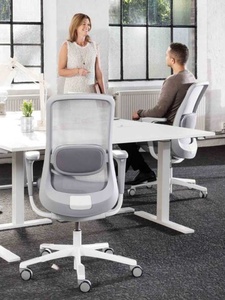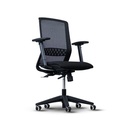Ergorest arm supports (pair) reduces muscle strain in shoulder muscle.
Ergorest arm supports and muscle strain in work with visual display units: a work site intervention
Introduction
In Finland, 42% of the work force used a visual display unit (VDU) regularly more than one hour a day in their work in 1997 (1). The introduction of new automatic dataprocessing applications and a mouse have increased the musculoskeletal load and disorders involved in VDU work mostly due to isometric load, repetitive work andthe required force output (2, 3). This type of muscular work may cause pain in neck and shoulders, and, when a mouse is used there can also be pain in the arms and hands (4).
Ergorest articulating arm supports were used in this study for reducing muscular load.
The effects of Ergorest arm supports on musculoskeletal load have been evaluated in simulated VDU work (5) and in light assembly work (6). Arm supports have not been studied at actual workstations in an intervention study.
The aim of this worksite intervention study was to assess the effects of Ergorest arm supports EMG activity of the upper trapezius muscles and extensor digitorum muscles on both sides of t body, and perceived musculoskeletal strain in the neck-shoulder-arm region during VDU work with the use of a mouse and a keyboard.
Material and methods
The subjects were 21 healthy female VDU users without acute musculoskeletal symptoms. Th were office employees and researchers aged 26-54 years.
The work-site intervention lasted for six weeks, and similar measurements were made before a after the intervention. After the first measurements the subjects were randomly assigned to thr groups of seven subjects. Group 1 used the basic Ergorest arm support with the mouse pad wi the hand that operated the mouse. Group 2 had Ergorest arm supports for both hands (a basic arm support with the mouse pad for the mouse hand and the basic arm support for the other hand). The control group had no arm supports, and they were asked to maintain their usual wor technique and to avoid all redesign measures at work during the intervention.
The surface EMG and perceived musculoskeletal strain were measured. The EMG was recorde from four muscles bilaterally (trapezius pars descendes and extensor digitorum) Average EMG values were calculated for the use of the mouse and the typing along with the proportion in relation to the maximal EMG (%MVC).
The subjects recorded the severity of their musculoskeletal strain in the neck-shoulder-arm reg during the past week using a visual analogue scale (VAS). The mean value of the VAS lines obtained from the six body regions (neck, shoulder, upper arm, forearm, wrist, and hand and fingers) were calculated for the right and left sides.
Results
There were no significant changes in the %MVC values between the groups before and after the intervention (Figures 1-4). The use of arm supports reduced the %MVC values of the left trapezius muscle significantly in Group 2 during the use of the mouse and the use of the keyboard. In addition the %MVC values of the control group during keybard use were significantly lower after the intervention period.















